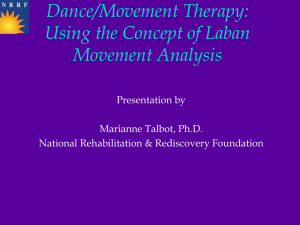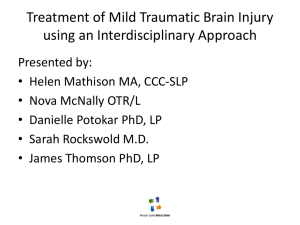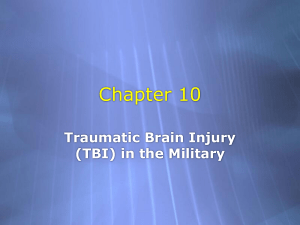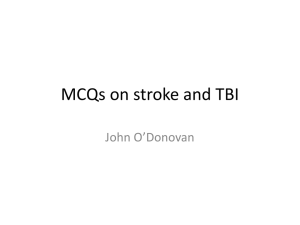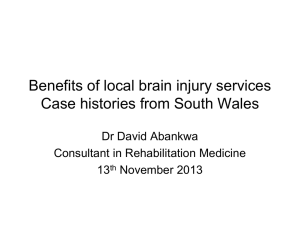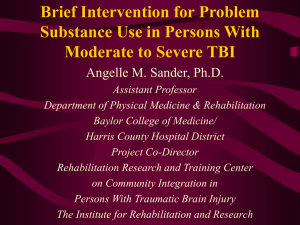SCI and Co-Occurring TBI - Medical University of South Carolina
advertisement
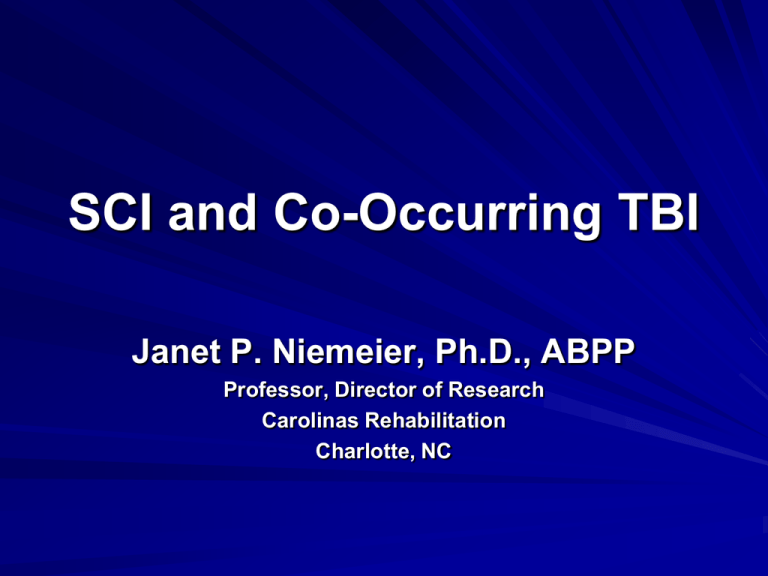
SCI and Co-Occurring TBI Janet P. Niemeier, Ph.D., ABPP Professor, Director of Research Carolinas Rehabilitation Charlotte, NC Disclosure of PI-RRTC Grant James S. Krause, PhD, Holly Wise, PhD; PT, and Elizabeth Walker, MPA have disclosed a research grant with the National Institute of Disability and Rehabilitation Research The contents of this presentation were developed with support from an educational grant from the Department of Education, NIDRR grant number H133B090005. However, those contents do not necessarily represent the policy of the Department of Education, and you should not assume endorsement by the Federal Government. Accreditation The Medical University of South Carolina is accredited by the Accreditation Council for Continuing Medical Education (ACCME) to provide continuing medical education for physicians. The Medical University of South Carolina designates this live activity for a maximum of 1.0 AMA PRA Category 1 Credit(s)™. Physicians should claim only the credit commensurate with the extent of their participation in the activity. In accordance with the ACCME Essentials &Standards, anyone involved in planning or presenting this educational activity will be required to disclose any relevant financial relationships with commercial interests in the healthcare industry. This information is listed below. Speakers who incorporate information about off-label or investigational use of drugs or devices will be asked to disclose that information at the beginning of their presentation. The Center for Professional Development is an approved provider of the continuing nursing education by the South Carolina Nurses Association, an accredited approver by the American Nurses Credentialing Center’s Commission on Accreditation Disclosure of Presenter Dr. Janet Niemeier does not have any financial disclosures. Continuing Education Conflict of Interest Continuing Nursing Education (CNE) credit: The Center for Education and Best Practice is an approved provider of continuing nursing education by the South Carolina Nurses Association, an accredited approver by the American Nurses Credentialing Center’s Commission on Accreditation. A conflict of interest occurs when an individual has an opportunity to affect educational content about health care products or services of a commercial interest with which she/he has a financial relationship. The planners and presenters of this CNE activity have disclosed relevant financial relationships with any commercial interests pertaining to this activity. A list of event sponsors and vendors may be found in your handouts or disclosure slide. The Center for Education and Best Practice has conflict of interest disclosures on file for all presenters and planners. Only RNs are eligible to receive nursing contact hours Each participant will receive two forms for CNE Verification of attendance Individual evaluation form Non-endorsement of Products For all CNE sessions, in order to receive full contact hour credit for the CNE activities, you must: Be present no later than five minutes after starting time Remain until the scheduled ending time Complete and return the evaluation form at the end of the session Provision of this education activity by the Center for Education and Best Practice does not imply endorsement by the Center or SCNA of any commercial products displayed in conjunction with this activity. Commercial support does not influence the design and scientific objectivity of any Center educational activity. Learning Objectives Attendees will be able to discuss: 1. The epidemiology of co-occurring SCI and TBI 2. TBI symptoms and challenges and how these complicate recovery from SCI 3. Best practices for identification and treatment of patients with both SCI and TBI Separate Epidemiology Traumatic Brain Injury 1.7 million a year SCI 11,000 a year – 82% male, – Average age 31 – 52% paraplegic, 47% quadriplegic Military study, OIF/OEF -- 10%, from blasts (Bell et al., 2009) and combat injuries (CDC) Causes of SCI (LeGrand, 10/16/10, C3/C4) Causes of SCI SCI/TBI Epidemiology Estimates vary depending on method of data collection, i.e., ICD-9 codes, neuroimaging, length of coma 24-59% (Sommer & Witkiewicz, 2004) 25% GCS (Wagner et al., 1984) 42% PTA/LOC (Davidoff et al., 1992) 46.7%; most mild (Hagen et al., 2010) 56% Neuropsychological test data (Wilmot et al., 1985) 60% GCS NIDRR diagnostic criteria, neurocognitive tests, PTA (Macchiocchi et al., 2008) 74% ACRM diagnostic criteria, diagnostic imaging Incidence is increasing (Telenon et al., 2007) Injury Variables Associated with CoOccurrence of TBI & SCI Cause –MVAs, falls, assaults, sports, combat SCI Level--Most common – – – – C5-8, Asia Grade A-C T 1-8, Asia Grade A-C T 9-12, Asia Grade A-C Completeness of injury Severity – Many with SCI have mild TBI Length of PTA, long is worse (Macchiocchi et al., 2008) Injury Variables Associated with CoOccurrence of TBI & SCI NIDRR classifications: – Mild (GCS = 13 – 15)** – mild complicated (cerebral pathology, contusion, hemorrhage, skull fx) – Moderate (GCS = 9 – 12) – Severe (GCS = 3 – 8) Gender male Ethnicity White Significant problem: Lack of ER, acute records CLASSIFICATIONS OF TBI Mild – GCS 13 – 15, ? To Min. LOC, ≤12 hours PTA, “post concussive syndrome” Symptom overlap with PTSD Moderate – GCS 9 – 12, ≤ 30 minutes LOC, ≤ 24 hours PTA Severe – GCS 3 – 8, > 30 minutes LOC, >24 hours PTA Co-Occurrence Risk Factors ETOH Completeness of Traumatic SCI Gender male Involvement in sports Professions or occupations requiring work at significant heights Combat exposure Early Assessment Tools and TBI Facts TBIMS Definition: Damage to brain tissue caused by an external mechanical force as evidenced by loss of consciousness or post traumatic amnesia (PTA) due to brain trauma, or by objective neurological findings Causes of TBI TBI Facts Annual incidence >1.5 million “Signature Wound” of global war on terrorism, >1,700 U.S. military (64%) since beginning of Middle Eastern conflict $4 million lifetime costs per person Greatest risk ages <5 and > 85 MVAs cause most severe injuries TBI Research Timeline First review of literature on TBI rehabilitation in 1998 (Cicerone, et al.) – Very little clinically useful work on efficacy of treatment – We need tested interventions, but most of the research studies and articles have focused on impairments, course of recovery, and ways to measure post-TBI function. Early Assessment Tools Length of coma* Time to commands* GCS* Admission FIMTM * InterD baseline evals Lots of challenges for examiners of acute patients Wiser make long-term recs based on evals completed during post acute phase *Assessment of Severity. Inpatient Baseline Evaluations Discipline specific: Speech Vision Hearing Practic functions/Sensory motor abilities Balance Gross motor/walking/wheel chair Endurance Cognitive status: Level of Agitation Social and emotional status Common Symptoms and Issues after TBI Symptoms Physical Perceptual Emotional Behavioral Social Cognitive Issues Pain Premorbid Comorbid Psychosocial The Scientific TBI Literature Tells Us… Primary Needs after TBI: Mild—Injury and coping Knowledge, reassurance, time, rehab for disruptive deficits, counseling (especially if PTSD) Moderate, Severe—Early and intensive rehab, knowledge, compensatory skills, opportunity for purpose and QOL, community and family supports The Scientific TBI Literature Tells Us… Factors in Long-term outcome: Age Gender Ethnicity Level of education Violence Severity Support network Family involvement LOC early rehab GCS on admit Site of injury Premorbid factors ER care Relationship stability The Scientific TBI Literature Tells Us… Evidence-Based, Effective Interventions: In General: Early, comprehensive Cognitive Rehabilitation: Visual scanning training Speech language therapy Problem Solving training Memory Retraining Electronic Assistive Devices Outcomes assessed with real world tasks practice The Scientific TBI Literature Tells Us… Post Injury employment outcomes affected most by: Premorbid employment status Ethnicity Functional status at rehab D/C Cognitive functioning Vocational rehabilitation Supportive employment No “gold standard” for defining productivity The Scientific TBI Literature Tells Us… Variables Associated with Quality of Life Outcomes: Being employed Activity Social integration Less severe injury Challenges to InterD Evaluations Polytrauma, medical problems Pain Reduced endurance Reduced time for assessment Less insurance coverage Symptom overlap Medication Effects Agitation, behavior problems Cultural Issues Setting priorities Perceptual, language, and motor deficits Limited Literature about Dual Dx Studies looking at long-term consequences of TBI and SCI Moderate/severe TBI + SCI = more personal and family adjustment difficulties than mild TBI and SCI (Richards et al., 1991) Fewer functional gains from pre- to post-treatment on FIM for SCI + TBI vs. SCI only (Macchiocchi et al., 2004) Worse neuropsychological test performance, more psychopathology and behavioral problems, greater demands on clinician resources, increased rehab costs (Bradbury et al., 2008) Limited Literature Small sample sizes Variation in methodologies Mostly epidemiological and descriptive Need more research on variables associated with outcome, best interventions Inconsistent information in acute or ER records—true of military records as well Persons with mild TBI often do not recall being injured or losing consciousness Military Co-Occurrence Military Study of Impact Blast and military grade weaponry on CNS (Bell et al., 2009) n = 40/408 (9.8% co-occurring SCI and TBI) No stratification in looking at outcomes, level of injury Challenges to Dual Diagnosis Often missed in ER Acute charts often have no information Motor performance is required on many cognitive tests Cognitive deficits can impair ability to follow test instructions Challenges to Treatment of DD Cognitive deficits Lead to: – Poor recall of therapists’ instructions and teaching/training Forgetting to do critical self care: – Pressure releases – Exercise – TLSO compliance – Forgetting precautions, getting up impulsively, and risking further injury Challenges to Treatment of DD Inability to retain vital educational portions of rehabilitation of the SCI due to cognitive deficits: B&B Nutrition Sexuality Avoidance of medical complications Challenges to Treatment Behavioral issues Agitation Aggression disinhibition initiation Social pragmatics Treatment disrupted Poor problem solving Aphasia—hard to make needs and feelings known Hard to understand therapists Challenges to Treatment Mood and coping issues are common in SCI – Depression, suicidal ideation – lethality worse after TBI Impaired self-awareness endangering self with impulsive behavior Losses doubled – Grief further complicate emotional responses to disability – Patients overwhelmed with 2 disorders to accept Major Issue: Psychotherapy helps with adjustment but is a talking enterprise – conceptually complex Challenges to Treatment Failure to educate staff, patients, and family about cognitive assessment findings Cognitive disability is overshadowed due to paralysis Patients can be labeled unmotivated, noncomplaint -- misinterpretation of their neurobehavioral symptoms Therapists frustrated by need to repeat info Variables Affecting Outcomes Type, severity, and number of neurobehavioral deficits Location of injury Cause Family support Social adjustment Treatment Recommendations NEED SPECIALIZED TREATMENT Neuropsychological assessment Carefully check acute and ICU record to confirm TBI, type and severity – Some biomarkers identified that can distinguish TBI + polytrauma from polytrauma alone Educate team, family and patient Normalize TBI symptoms, feelings Family hands-on training Behavior management Chemical restraints Treatment Recommendations POA and decision-making issues clarified Train patient in purposive and consistent use of compensatory cognitive strategies Repeat instructions and provide written backup Use of schedule, calendar, memory log (if able) Link patient and family with community resources Manage pain effectively Treatment Recommendations Reduce size of education and support groups— two leaders If possible, match group members by cognitive level Simplify language Consider education on an individual basis Visual aids Opportunities to practice, apply concepts and skills Dry Erase board Treatment Recommendations Gently redirect if attention wanders Awards/incentives for compliance TBI focus in education first….as cognition improves, then start SCI ed Have Dual Dx patients attend educational series more than once Use of task analysis to train Use consulting experts on both diagnoses Predictors of Outcomes Length of Post traumatic amnesia (PTA) >14 days, or time to commands Severity of cognitive deficits Violence associated with Injury Early rehabilitation Vocational rehabilitation Gender Ethnicity (Heineman et al., 2002; Macchiocchi et al., 2008; Williams-Gary et al., 2009; ) Clinical and Economic Consequences Economic as well as clinical burden Increased rehabilitation costs Increased burden on clinician resources and time More nursing care Longer LOS-More time needed to achieve comparable gains (Bradbury et al., 2008) Further Research Intervention studies Translational research Protocol or manualization/critical path with specialized assessment and interventions Prevention Improved informatics to track trends and associations that will help us learn more Care at ERs and in the field to carefully assess for and note both disorders Thank you and Janet.niemeier@carolinashealthcare.org


